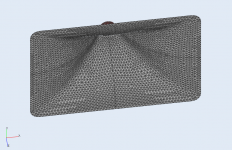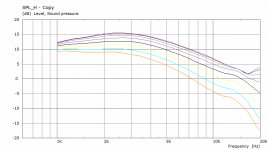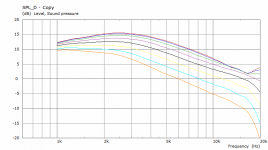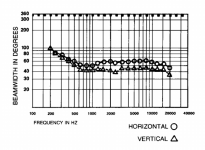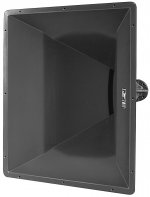It would be really cool to be able to set that up in ATH directly, but in the meantime I'm trying to modify demo1 manually for CircSym.
I updated Dim=CircSym and MeshFrequency=50000 in the solving.txt, and it appears to solve the BEM very quickly. When I try to solve the spectra, however, I get the following errors:
What am I missing?
I updated Dim=CircSym and MeshFrequency=50000 in the solving.txt, and it appears to solve the BEM very quickly. When I try to solve the spectra, however, I get the following errors:
Code:
DrvGroup=1001 missing in Solving-script
Spectrum calculation
Number of data-sets 46
Observation script observation.txt
Frequency range 500Hz...20kHz, Abscissa = log, NumFrequencies = 30
Threads used 8
Curve empty - no data in "BE_Spectrum #3" in script "observation.txt"
Curve empty - no data in "BE_Spectrum #4" in script "observation.txt"
Curve empty - no data in "BE_Spectrum #4" in script "observation.txt"
Curve empty - no data in "BE_Spectrum #4" in script "observation.txt"
Curve empty - no data in "BE_Spectrum #4" in script "observation.txt"
Curve empty - no data in "BE_Spectrum #4" in script "observation.txt"
Curve empty - no data in "BE_Spectrum #4" in script "observation.txt"
Curve empty - no data in "BE_Spectrum #4" in script "observation.txt"
Curve empty - no data in "BE_Spectrum #4" in script "observation.txt"
Total thread time elapsed 00:00:00
Spectrum calculation finished
Rendering spectral curves to COM
Ready, curves are available at VACSWhat am I missing?
I've never tried to use the same mesh file for CircSym as for 3D but I think it won't work that way, based on what's in the documentation. I think that for a CircSym you really need a different boundary representation, i.e. a list of 2D points (axial, radial coordinates) and line segments between them as the boundary elements, i.e a completely different project.
As I work on it, it will be possible to define a profile index for which a CircSym project will be generated.
As I work on it, it will be possible to define a profile index for which a CircSym project will be generated.
Last edited:
I mean, if you're being pedantic about it, axisymmetry is a subset of symmetry, like squares within rectangles.You mean axisymmetrical (i.e. 'round') waveguide?
A symmetrical waveguide would be square, for instance 60 x 60°.
No intention to be pedantic (regarding semantics).
In the context of acoustic characteristics, simulation and the final production of waveguides, there are substantial differences between a 'simple' axisymmetric waveguide and the more exotic ATH4 variants.
The godfather of the acoustic waveguide, Dr. Geddes, has repeatedly stated that he saw no reason to deviate from the original concept (axisymmetric).
Moreover, mabat has shown that an optimized axisymmetrical waveguide is not, or hardly inferior to the other variants.
In the context of acoustic characteristics, simulation and the final production of waveguides, there are substantial differences between a 'simple' axisymmetric waveguide and the more exotic ATH4 variants.
The godfather of the acoustic waveguide, Dr. Geddes, has repeatedly stated that he saw no reason to deviate from the original concept (axisymmetric).
Moreover, mabat has shown that an optimized axisymmetrical waveguide is not, or hardly inferior to the other variants.
Last edited:
My take on that (and I may repeat myself): Axisymmetric can be exemplary but it needs to be really big for that to happen. You can make as good (if not better) waveguide by making it non-axisymmetric and smaller. That's what I've found out. My best one so far, considering acoustic performace only, is not axisymmetric. You can eliminate the pattern flip simply by not making it greatly non-symmetric.
Last edited:
It's neither necessary nor useful to argue about the actual performance differences between axisymmetrical and other types of ATH4 waveguides.
Well executed samples should be best of class either way.
The thought behind my previous posts was to provide newcomers some guidance on the differences between those 2 types.
It makes sense to read the last part of a thread first, before plowing through a few hundred pages.
Although I have already seen some examples of beautifully made rectangular ATH4s, there are probably also people who do not want to use a 3D printer, or a CNC milling cutter. Others simply prefer the looks of an axisymmetrical waveguide.
Well executed samples should be best of class either way.
The thought behind my previous posts was to provide newcomers some guidance on the differences between those 2 types.
It makes sense to read the last part of a thread first, before plowing through a few hundred pages.
Although I have already seen some examples of beautifully made rectangular ATH4s, there are probably also people who do not want to use a 3D printer, or a CNC milling cutter. Others simply prefer the looks of an axisymmetrical waveguide.
Last edited:
Some results from this morning - rectangular waveguide 280 x 200 x 90 mm (quite small), 1" throat:
(0 - 52.5 / 7.5 deg; infinite baffle)
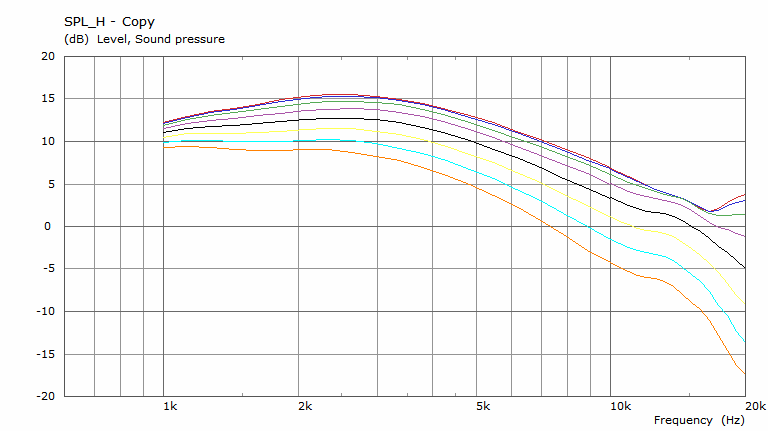
(0 - 52.5 / 7.5 deg; infinite baffle)
Attachments
Last edited:
I have a good cooling so it makes almost no sound during the calculation. Can't tell, really.
You can eliminate the pattern flip simply by not making it greatly non-symmetric.
Mabat, in your estimation, what is the aspect ratio we need to stay under to avoid pattern flip?
I think i recall Tom D as having said 1.6x is about the upper limit. And i assume that he was talking about his straight-walled conical synergy horns probably including secondary flares.
My synergy efforts at 1.5x measure with some flip, albeit mild enough to easily live with.
Very interested in your take for your far more sophisticated horns...thx.
i'm no Tom Danley and largely misunderstand some horn math so permit me to be wrong but i don't think aspect ratio alone affects pattern flip does it not also depend on the defined bandwidth of operation?
Mark, for synergy horns, an asymmetrical mouth with respect to opening angles would work wonders in combatting pattern flip,
as C-C spacing is irrelevant.
An example of a 60 x 40° horn, with mouth dimensions: 28 x 32" (W X H).
as C-C spacing is irrelevant.
An example of a 60 x 40° horn, with mouth dimensions: 28 x 32" (W X H).
Attachments
Last edited:
Is foam then, like internal cabinet damping materials, significantly less effective when used at a pressure antinode?
No velocity and there is no friction or loss, so yes it is less effective as all damping would be.
I hoped you would 🙂
I may be force3d to as I have a consulting job needing a horn. But its such a simple horn that the tools here may not be required.
I think that you have answered all the questions that I have had over the years. Basically getting rid of slope discontinuities is the key. After that shape has a lesser effect almost to the point of negligible.
Dr. Geddes, has repeatedly stated that he saw no reason to deviate from the original concept (axisymmetric).
Moreover, mabat has shown that an optimized axi-symmetrical waveguide is not, or hardly inferior to the other variants.
From my POV, the advantages of non-axio were outweighed by the increase difficulty. I could make axi, I could not make non-axi, so that was a big limitation. Having now seen the effects of asymmetry I am still not sure that it is a major improvement or even worth doing.
Hi,
Was asking myself, MrEarl G. : ossible to form horns with the olymer you use for your cabinet ? Or not possible ause not supporting the comlex tools Mabbat shoes to shape horn from vacum ?
Was asking myself, MrEarl G. : ossible to form horns with the olymer you use for your cabinet ? Or not possible ause not supporting the comlex tools Mabbat shoes to shape horn from vacum ?
Hi turk, i thought pattern flip is pretty much entirely due to aspect ratio.
And that it occurs when the narrower pattern, which is the smaller horn dimension, looses control and its pattern goes wider than the larger pattern, larger horn dimension, still maintaining control....
So yeah, a function of frequency, but a function due to H vs V aspect...
Just my laymen's understanding though...no doubt more to it...always is huh?🙂
And that it occurs when the narrower pattern, which is the smaller horn dimension, looses control and its pattern goes wider than the larger pattern, larger horn dimension, still maintaining control....
So yeah, a function of frequency, but a function due to H vs V aspect...
Just my laymen's understanding though...no doubt more to it...always is huh?🙂
Hi Ro808,
Do you know if that horn had a secondary flare?
I've built synergies (WxH) 90x60 (49x28") , 60x40 (48x28"), and 60x60 (30x30") .
All were helped by secondary flares, in theory with Keele's classic paper and in practice with BWaslo's synergy spreadsheet calcs.
http://www.xlrtechs.com/dbkeele.com/PDF/Keele (1975-05 AES Preprint) - Whats So Sacred Exp Horns.pdf
I think that's what so neat about the horns you guys discuss here...no secondaries needed..and smoother response over all.
Now if you folks will just please get these awesome designs going where we can mount some dang cones onto their sides....😀
Do you know if that horn had a secondary flare?
I've built synergies (WxH) 90x60 (49x28") , 60x40 (48x28"), and 60x60 (30x30") .
All were helped by secondary flares, in theory with Keele's classic paper and in practice with BWaslo's synergy spreadsheet calcs.
http://www.xlrtechs.com/dbkeele.com/PDF/Keele (1975-05 AES Preprint) - Whats So Sacred Exp Horns.pdf
I think that's what so neat about the horns you guys discuss here...no secondaries needed..and smoother response over all.
Now if you folks will just please get these awesome designs going where we can mount some dang cones onto their sides....😀
Hi,
Was asking myself, MrEarl G. : ossible to form horns with the olymer you use for your cabinet ? Or not possible ause not supporting the comlex tools Mabbat shoes to shape horn from vacum ?
One can easily cast any shape in polyurethane, all you need is a mold - two part. Cast, wait a couple hours and take out the device. Molds have to be CNC'd of course, and that's more than I ever had available - except maybe a couple times when I had to have CNC. But it was just so expensive.
You should edit your posts!
Hi turk, i thought pattern flip is pretty much entirely due to aspect ratio.
And that it occurs when the narrower pattern, which is the smaller horn dimension, looses control and its pattern goes wider than the larger pattern, larger horn dimension, still maintaining control....
So yeah, a function of frequency, but a function due to H vs V aspect...
Just my laymen's understanding though...no doubt more to it...always is huh?🙂
That's the basic idea. But Mabat showed how aspects other than 1 can be done without pattern flip - if all the parameters are set right.
Do you know if that horn had a secondary flare?
Yes, although more pronounced in the horizontal plane.
Attachments
- Home
- Loudspeakers
- Multi-Way
- Acoustic Horn Design – The Easy Way (Ath4)
